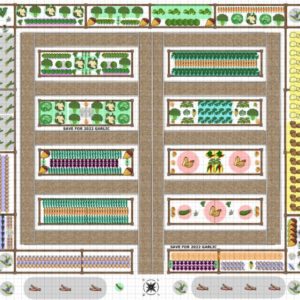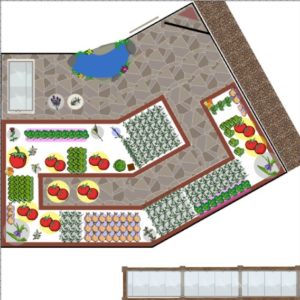It’s the end of February, and despite the winter cold, the garden is not far from my mind. The greenhouse has been keeping us supplied with veggies all winter, in addition to what was stored from the 2020 summer garden outdoors.
OUTDOOR GARDEN

My GrowVeg Garden Planner is complete for summer 2021. Some changes are likely to be made, but the plans are in motion, the seeds have been ordered and arrived, the calendar reminders have been set. A few seedlings have already been started.
I have been using this GrowVeg Garden Planner for many years both in my former garden and here in Guffey. GrowVeg has made some changes this year due to the end of Flash Player, and now it’s faster, easier to use, and they’ve made some great changes. I was able to be a beta tester for this new planner, and had a lot of fun trying it out during the later planning stages.
As always, I’ve rotated my crops as much as possible and have planned in advance which beds will be started earlier and which will be later, as well as which will be saved for my 2022 Garlic. This year I will try a few new varieties of veggies I’ve grown before, but no new veggies. As usual, I’m keeping the things that need to be covered the most in the interior beds, as these are the easiest to cover with plastic over the hoops. The perimeter beds are primarily garlic, onions, potatoes, beets & parsnips. The horizontal perimeter beds across the top of the plan receive the most sun in the fall when it is lower in the sky, so I’m planning the crops to be harvested last in that area: my second planting of broccoli, cabbage, cauliflower, brussels sprouts, some spinach, lettuce and carrots. All of these can be harvested after a few light frosts, and the sun will help them warm up to grow as long as possible.
Tim & I are planning better ways to cover the perimeter beds with frost cloth for those first few weeks when there will likely be frost and a snowstorm or two. Our old frostcloth has gotten rather ratty & mouse-eaten, so we purchased enough new frostcloth to cover just about all the beds. This is in addition to the plastic we use to cover the most susceptible plants in the interior areas.
Hopefully this year we will not have the problems with the mice and pack rats as we did last year. The bait traps Tim had put out really seemed to keep them under control the later part of the summer. By having them in place throughout the winter & spring, we hope to prevent all damage to the garden. We may make a few changes to the way we protect things from the spring cold & snow with better supports for frost cloth and/or plastic, and make it easier to put them out at night and remove them in the morning.
GREENHOUSE
The greenhouse has been growing great! In the fall I planted some broccoli, cauliflower, cabbage, lettuce, tomatoes & zucchini. We’ve really enjoyed eating these fresh from the greenhouse. A couple of my tomatoes have produced the best tomatoes I’ve ever grown in the greenhouse. The Oregon Spring & Siletz tomatoes have been big, meaty, juicy, with few seeds and easy to peel when I don’t want the skins. Since I’ve had such an abundance, I’ve frequently used them for any recipe that uses diced tomatoes or tomato sauce. I think they liked the location (or I did a better job of keeping them fertilized!).

I’ve used the Garden Planner extensively for the greenhouse as well. The “In-Ground Dates” feature in the planner is especially helpful. The photo at the right shows the greenhouse plan for the end of February. With the Planner I am able to show specific plants for each month of the year. Since my greenhouse is used constantly, taking out old plants and replacing the spot with new ones, this really helps me keep track of things and plan ahead. I’m able to start seedlings on my grow bench under lights, preparing them to go in where something else will be removed. At the bottom I’ve added our three cold frames, which may be planted in March with lettuces, spinach, and perhaps some onions to transplant later to the garden.
GREENHOUSE COVER CROPS
This year I’ve felt like I may have been overworking the soil in the greenhouse. Even though I typically refresh the soil by adding compost, vermicompost, aged manure & fertilizers each time something is planted, I fear that is not enough. Without going to the trouble of allowing a long rest period or removing all the soil and replacing it, I’m experimenting with planting some cover crops, some of which are shown in this February plan. I tilled in some well-aged horse manure or some fairly fresh duck manure and a bit of vermicompost, then scattered seeds of mustards, cowpeas, buckwheat & daikon radish. I’m giving them a chance to sprout & grow a bit, then tilling them in. In some cases, I’ve planted pretty soon after tilling these in, but in some of the larger areas I’m experimenting with solarizing the soil by covering the area with clear plastic. The solarizing should heat up the soil and kill diseases which could be in the soil. Hopefully this will only take 2-3 months and should help recondition my tired soil. There should be an update later on how well this goes, but I won’t have actual “data” and will only know by how well the plants grow. As it is said, “Only time will tell.”
